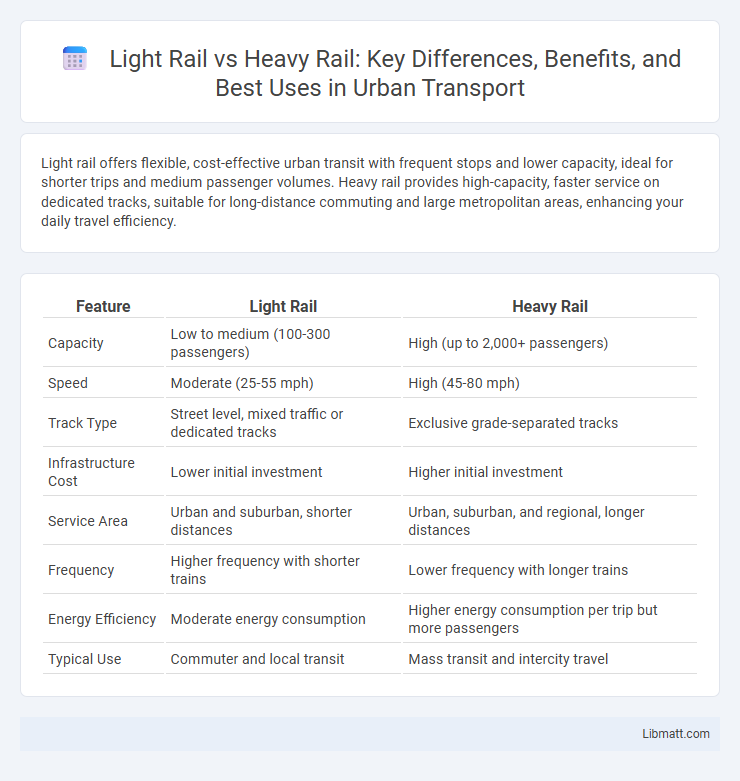Light rail offers flexible, cost-effective urban transit with frequent stops and lower capacity, ideal for shorter trips and medium passenger volumes. Heavy rail provides high-capacity, faster service on dedicated tracks, suitable for long-distance commuting and large metropolitan areas, enhancing your daily travel efficiency.
Table of Comparison
| Feature | Light Rail | Heavy Rail |
|---|---|---|
| Capacity | Low to medium (100-300 passengers) | High (up to 2,000+ passengers) |
| Speed | Moderate (25-55 mph) | High (45-80 mph) |
| Track Type | Street level, mixed traffic or dedicated tracks | Exclusive grade-separated tracks |
| Infrastructure Cost | Lower initial investment | Higher initial investment |
| Service Area | Urban and suburban, shorter distances | Urban, suburban, and regional, longer distances |
| Frequency | Higher frequency with shorter trains | Lower frequency with longer trains |
| Energy Efficiency | Moderate energy consumption | Higher energy consumption per trip but more passengers |
| Typical Use | Commuter and local transit | Mass transit and intercity travel |
Introduction to Light Rail and Heavy Rail
Light rail systems typically operate on urban streets and dedicated tracks with moderate capacity, offering flexible and frequent transit options for city commuters. Heavy rail features higher capacity trains running on exclusive tracks, designed for longer distances and faster speeds in metropolitan regions. Understanding the differences in infrastructure, speed, and passenger volume helps you choose the best transit solution for your transportation needs.
Defining Light Rail: Key Features
Light rail systems typically operate with smaller, lighter vehicles designed for frequent stops and moderate passenger capacity, often running on shared or dedicated tracks within urban areas. They offer flexible routing options, including street-level operation, which enhances accessibility and integration with city infrastructure. Your choice of light rail can reduce congestion while providing efficient, environmentally friendly transit solutions for medium-demand routes.
Defining Heavy Rail: Key Features
Heavy rail, also known as metro or subway systems, operates on exclusive rights-of-way, allowing for high-capacity, high-speed urban transit with frequent service intervals. Key features include long trains with multiple cars, fixed stations spaced farther apart than light rail, and electrified tracks typically powered by third rail or overhead catenary systems. These systems prioritize rapid passenger movement in dense metropolitan areas, offering greater speed and volume compared to light rail networks.
Technology and Infrastructure Differences
Light rail systems utilize electrically powered vehicles that often operate on street-level tracks with flexible routing, requiring lighter infrastructure such as smaller gauge rails and less robust trackbeds. Heavy rail, also known as metro or subway systems, employs larger, high-capacity trains running on dedicated, grade-separated tracks with extensive tunneling or elevated structures, supported by more complex signaling and power supply systems. The technological distinction includes lighter weight and lower speed for light rail, while heavy rail emphasizes higher speeds, greater passenger loads, and enhanced safety through fully controlled environments.
Capacity and Speed Comparison
Heavy rail systems typically offer higher capacity, accommodating large numbers of passengers per train due to longer car lengths and more cars per trainset. They also achieve greater speeds, often exceeding 50 mph, making them suitable for longer distance commuting and express service. Light rail, with shorter trains and lower top speeds around 25-35 mph, emphasizes frequent stops and urban accessibility but generally handles fewer passengers per trip compared to heavy rail.
Cost Analysis: Construction and Operation
Light rail systems generally incur lower construction costs due to their ability to operate on existing roadways and require less extensive infrastructure compared to heavy rail, which demands substantial investment in dedicated tracks, tunnels, and stations. Operational expenses for light rail tend to be lower as well, with smaller trainsets and lower energy consumption, while heavy rail incurs higher costs driven by larger trains, greater staffing needs, and more complex maintenance requirements. The cost-benefit analysis often hinges on passenger volume and service frequency, where heavy rail is more cost-effective at high capacities despite the upfront capital intensity.
Urban Integration and Land Use
Light rail systems offer greater urban integration by operating on surface streets and allowing flexible routing through dense city centers, supporting mixed-use development and pedestrian-friendly environments. Heavy rail requires dedicated rights-of-way and larger stations, which often lead to more substantial land acquisition and urban disruption but provide higher capacity and faster travel over longer distances. Efficient land use is optimized in light rail through smaller infrastructure footprints, while heavy rail's extensive infrastructure supports significant transit-oriented development around major transit hubs.
Environmental Impact and Sustainability
Light rail systems typically have a lower environmental impact due to their smaller size, lower energy consumption, and ability to operate on renewable energy sources, making them more sustainable for urban transit. Heavy rail systems, while capable of transporting larger volumes of passengers, often require more substantial infrastructure and energy, which can increase their carbon footprint. Your choice between light rail and heavy rail should consider the balance between capacity needs and environmental sustainability goals.
Passenger Experience and Accessibility
Light rail systems often provide a more flexible and frequent service, featuring low-floor vehicles for easy boarding, which enhances accessibility for passengers with mobility challenges. Heavy rail networks typically accommodate higher passenger volumes with faster travel speeds, but may involve stairs and elevated platforms that can complicate access for some users. Both modes aim to optimize passenger comfort, yet light rail's integration into urban streetscapes generally supports smoother access and more frequent stops.
Choosing the Best Option: Factors to Consider
Choosing the best option between light rail and heavy rail depends on factors such as passenger capacity, urban density, and budget constraints. Light rail is ideal for medium-capacity transit in areas with moderate traffic and limited space, while heavy rail supports high-capacity, rapid transit in densely populated regions. Your decision should also consider infrastructure costs, operational flexibility, and future scalability to ensure optimal transit efficiency.
light rail vs heavy rail Infographic

 libmatt.com
libmatt.com